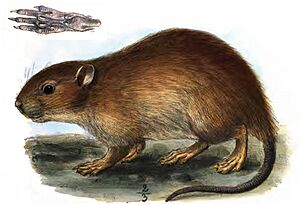Short-tailed bandicoot rat facts for kids
Quick facts for kids Short-tailed bandicoot rat |
|
|---|---|
 |
|
| Conservation status | |
| Scientific classification | |
| Genus: |
Nesokia
|
| Species: |
indica
|
| Synonyms | |
|
|
The short-tailed bandicoot rat (Nesokia indica) is a type of rodent found in Asia and North Africa. It belongs to the family Muridae, which includes many rats and mice. People also call it the short-tailed mole-rat, Indian bandicoot, or flat-tooth rat.
Contents
What Does It Look Like?
The short-tailed bandicoot rat usually has brown fur on its back. Its underside is lighter, and sometimes it has a white spot on its throat. In winter, its fur is long, thick, and soft. But in summer, it becomes short and bristly. Its wide feet and tail have very little hair. Each front foot has four working toes, and each back foot has five. All toes have strong, almost straight claws. These rats weigh between 182 and 388 grams. They are about 16.5 to 21.8 centimeters long.
Where Do They Live?
These rats live in many parts of Asia and North Africa. You can find them in river valleys, near lakes, and in areas where farms use irrigation. They live from Xinjiang in China all the way to Egypt. They are also found as far north as Uzbekistan and south to Bangladesh.
How Do They Live?
The short-tailed bandicoot rat is active at night. It spends most of its time in a complex burrow system. These burrows have many tunnels and rooms. They can go as deep as 60 centimeters underground. A single burrow might be up to 9 meters long. It can cover an area of up to 120 square meters. One special room is lined with plants for nesting.
Reproduction and Life Cycle
Scientists believe the mother rat is pregnant for about 17 days. They can have three litters of pups each year. Each litter usually has three to five babies. Breeding starts in March. In places with warm winters, they can have babies all year round.
Their Role in Nature
The short-tailed bandicoot rat is quite common. Its numbers can grow very large when conditions are good. They prefer wet areas. These rats can cause a lot of damage to farm crops. They dig tunnels that harm plants. They eat grasses, grains, roots, fruits, and vegetables. They also dig tunnels in the walls of irrigation canals. This can cause leaks and even floods. Many animals hunt these rats. Their predators include jackals, foxes, jungle cats, polecats, weasels, snakes, and even domestic cats and dogs.


